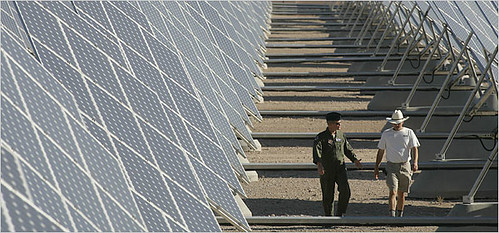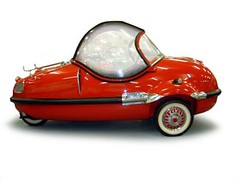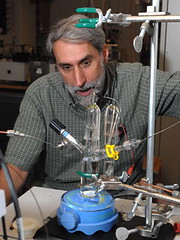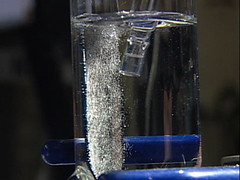There is no such thing as "clean coal", environmental lawyer Robert F. Kennedy Jr. stated in an interview with the Real News Network. His remarks followed a panel presentation on clean coal that included Dr. Hansen, the NASA scientist who has been warning about the dangers of global warming for a number of years. The consensus is clear and direct: coal is dirty and destructive.
A roving compendium of ecocentric energy options, including advances in solar and wind power, hybrid vehicles, and other thoughtful, balanced approaches to renewable energy.
Sunday, August 31, 2008
Tuesday, August 19, 2008
Solar Energy Scales to New Levels

The 14-megawatt solar power installation (shown in the photo) that operates at Nellis Air Force Base in Nevada is about to be upstaged by a planned installation in California with an 800-megawatt capacity.
As the New York Times reports in Two Large Solar Plants Planned in California, the two photovoltaic installations, now being planned for central California, will produce power at a scale equivalent to a small nuclear power plant when the sun is shining brightly. The scale of this project is a clear indication that solar power has reached a new milestone. Pacific Gas & Electric will purchase the power from the two companies behind the installations: Optisolar and SunPower Corporation.
The companies said they were forbidden by contract terms to talk about price, and a spokeswoman for Pacific Gas & Electric said her company was trying to obtain the best possible deal for ratepayers by not telling other suppliers of renewable energy what it was willing to pay.
But all three companies said the costs would be much lower than photovoltaic installations of the past.
To some degree, these two installations are driven by recent mandates legislated in California, requiring energy producers to reach a level of 20 percent renewables by 2010. But, they also serve as a proof-of-concept that solar can generate power at a vastly larger scale than in the past using the latest technologies.
Labels:
electricity,
energy,
environment,
photovoltaic,
power,
solar
Tuesday, August 05, 2008
Reviving the Lost Arts: Fuel-Sipping Microcars

The classic expression, "Necessity is the mother of invention", was proven beyond doubt in post-WWII Europe where the severe fuel shortages inspired automakers to create a variety of microcars. Often capable of hitting 70mph and traveling 90 miles on a gallon of fuel, these fuel-efficient wonders were manufactured in volume--perhaps 250,000 were produced in the years following the war.
The auto in the photo, a 1956 Avolette Tourisme, is part of a microcar collection owned by Bruce Weiner (who owes his fortune to Dubble Bubble gum). An entertaining piece by Bo Emerson in the Atlanta Car News talks about Weiner's obsession with these vehicles and charts the history of microcars.
Microcars were created out of necessity. Not only was gasoline at a premium, but manufacturers were short of money and materials. Messerschmitt was banned from building fighter planes and turned out sewing machines and refrigerators.
Entrepreneurs such as Fritz Fend (builder of the F.M.R.), created small shops, then collaborated with larger manufacturers. (Fend built thousands of vehicles in the Messerschmitt factories.) Some microcars were little more than enclosed, three-wheeled motorcycles.
The microcar craze lasted through the mid-1960s; by then European fortunes had risen, and customers demanded cars that could seat a family comfortably.
We had practical electric cars in the early 1900's, as well, phased out as our oil addiction grew by leaps and bounds. Perhaps it's time to revive some of these lost arts and build a new generation of microcars and electric vehicles--the necessity is cleary at hand.
Labels:
automobiles,
city planning,
efficiency,
electric car,
energy,
environment,
oil,
transportation
Saturday, August 02, 2008
Storing Solar Energy the Way Plants Do

One of the chief complaints about the practicality of solar energy has been: what do you do when the sun isn't shining? MIT researchers have come up with an answer: using a technique similar to that used by plants during photosynthesis. The development of a new catalyst to produce oxygen when an electrical current is passed through water, working in combination with another catalyst that produces hydrogen gas, becomes a powerful mechanism for charging fuel cells. This stored energy can be released as needed, a virtually carbon-free source of electricity that is available day or night.

As quoted in an article for the MIT News by Anne Trafton, Daniel Nocera, the Henry Dreyfus Professor of Energy at MIT, who has co-authored a paper on this discovery for the July 31, 2008 issue of Science, sees this as a landmark advance in energy production.
"This is just the beginning," said Nocera, principal investigator for the Solar Revolution Project funded by the Chesonis Family Foundation and co-Director of the Eni-MIT Solar Frontiers Center. "The scientific community is really going to run with this."
Nocera hopes that within 10 years, homeowners will be able to power their homes in daylight through photovoltaic cells, while using excess solar energy to produce hydrogen and oxygen to power their own household fuel cell. Electricity-by-wire from a central source could be a thing of the past.
Nocera also points out that the amount of sunlight that strikes the Earth in one hour is sufficient to supply the energy needs of the entire planet for a year.
In a video post on the MIT site, Nocera talks more about the potential of this new process.
Labels:
electricity,
energy,
environment,
photosynthesis,
photovoltaic,
solar
Subscribe to:
Posts (Atom)